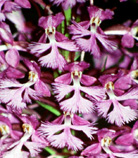Platanthera psycodes (L.) Lindley
Small purple fringed-orchid
The specific epithet psycodes is an incorrect spelling (by Linneaus) of
the Greek psychodes, meaning "butterfly-like," apparently
a reference to the appearance of the flowers.


DESCRIPTION: Plant glabrous,
arising from a cluster of fleshy, thickened roots, 20-90 cm tall. Leaves
2-5, lanceolate to elliptical to obovate, gradually reduced to lanceolate
bracts higher up on the stem, 5-19 cm long and 2-7 cm wide, keeled. Inflorescence
a loose or dense raceme, 20-50(-100) flowered; flowers lilac-purple to reddish-purple
or rarely white, fragrant, each flower subtended by a lance-linear, acuminate
bract. Sepals ovate-elliptic to ovate, 4-6 mm long and 2-4 mm wide,
colored as flowers; dorsal sepal loosely connivent with petals, lateral
sepals concave, reflexed. Petals obovate to spatulate, 4-9 mm long
and 2-6 mm wide, the margin finely lacerate or toothed, loosely appressed
to the dorsal sepal and colored as the sepals. Labellum tripartite
and fringed (the divisions typically reaching much less than halfway to
the base of the labellum), shallowly clawed, each segment of labellum fan-shaped;
7-13 mm long and 7-15 mm wide, colored as flowers but with claw typically
white; base of labellum with a +/- clubbed nectar spur projecting
behind, 1.3-2.5 cm long.
SIMILAR SPECIES: It is unlikely that Platanthera psycodes could
be confused with any other species in the Wisconsin flora. Rare albino individuals
could be confused with either P. leucophaea
or P. lacera. See both of those species
for a discussion of how distinguish them from an albino P. psycodes.
HABITAT: Platanthera psycodes inhabits a variety of moist, open
habitats. Typical habitats include stream and river banks, roadside ditches,
and moist meadows.
FLOWERING DATES: July 5-August 15.
POLLINATION: Stoutamire (1974)
observed butterflies and diurnal hawkmoths, as well as nocturnal moths,
pollinating Platanthera psycodes. Sky Feller (personal communication)
has recently observed the same groups of insects pollinating P. psycodes.
DISCUSSION: This is perhaps the most beautiful orchid in the Wisconsin
flora. If it could be cultivated successfully, it would make a wonderful
addition to any garden. Unfortunately, attempts to asymbiotically propagate
Platanthera psycodes have been largely unsuccessful. I have begun
an attempt to symbiotically germinate and grow P. psycodes which
will hopefully succeed.
WI DISTRIBUTION:  U.S. DISTRIBUTION:
U.S. DISTRIBUTION:
Go directly to Wisconsin herbarium records.
Return
to the main LIST of the Orchids of Wisconsin.
Return to the main KEY to the Orchids of
Wisconsin.


 U.S. DISTRIBUTION:
U.S. DISTRIBUTION: